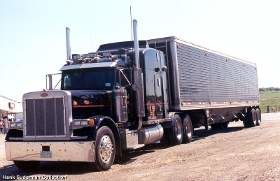Floating The Gears, Double Clutching ?
Topic 13813 | Page 1
Class A CDL DMV tests (and most company road tests) require you to double-clutch.
I got so used to floating in school - that my shifting for the road test was HORRIBLE.
So horrible in fact, I failed my first road test on bad shifts.
Once you get out OTR - you're (likely) free to go back to floating. In fact, many fleets are going to all automated-shift transmissions.
"Automatic Transmissions" in Class 8 trucks, is a misnomer. They don't have "torque converters" (ie: fluid drive) - they are automated shift manual gearboxes.
Rick
CDL:
Commercial Driver's License (CDL)
A CDL is required to drive any of the following vehicles:
- Any combination of vehicles with a gross combined weight rating (GCWR) of 26,001 or more pounds, providing the gross vehicle weight rating (GVWR) of the vehicle being towed is in excess of 10,000 pounds.
- Any single vehicle with a GVWR of 26,001 or more pounds, or any such vehicle towing another not in excess of 10,000 pounds.
- Any vehicle, regardless of size, designed to transport 16 or more persons, including the driver.
- Any vehicle required by federal regulations to be placarded while transporting hazardous materials.
OTR:
Over The Road
OTR driving normally means you'll be hauling freight to various customers throughout your company's hauling region. It often entails being gone from home for two to three weeks at a time.
Dm:
Dispatcher, Fleet Manager, Driver Manager
The primary person a driver communicates with at his/her company. A dispatcher can play many roles, depending on the company's structure. Dispatchers may assign freight, file requests for home time, relay messages between the driver and management, inform customer service of any delays, change appointment times, and report information to the load planners.DMV:
Department of Motor Vehicles, Bureau of Motor Vehicles
The state agency that handles everything related to your driver's licences, including testing, issuance, transfers, and revocation.
As stated above, you'll double clutch for training and road evals, when you get your own truck or even if you have to do training with a trainer, you can probably float....
Double Clutch:
To engage and then disengage the clutch twice for every gear change.
When double clutching you will push in the clutch, take the gearshift out of gear, release the clutch, press the clutch in again, shift the gearshift into the next gear, then release the clutch.
This is done on standard transmissions which do not have synchronizers in them, like those found in almost all Class A trucks.

Thanks for the info. Again TT is the best place to go to get great and helpful info.

Guess it just goes to show that different places have different rules, I personally have never, even one time been graded on my ability to double clutch , and have floated gears since day 1, always heard that a lot of places like to grade with it but it isn't something I have ever seen
Double Clutch:
To engage and then disengage the clutch twice for every gear change.
When double clutching you will push in the clutch, take the gearshift out of gear, release the clutch, press the clutch in again, shift the gearshift into the next gear, then release the clutch.
This is done on standard transmissions which do not have synchronizers in them, like those found in almost all Class A trucks.
Guess it just goes to show that different places have different rules, I personally have never, even one time been graded on my ability to double clutch , and have floated gears since day 1, always heard that a lot of places like to grade with it but it isn't something I have ever seen
I don't know when you took your original driving test to get your CDL but I took mine in '93 and you most certainly had to double clutch back then. I've never heard of a state that would allow you to float gears on a CDL exam.
CDL:
Commercial Driver's License (CDL)
A CDL is required to drive any of the following vehicles:
- Any combination of vehicles with a gross combined weight rating (GCWR) of 26,001 or more pounds, providing the gross vehicle weight rating (GVWR) of the vehicle being towed is in excess of 10,000 pounds.
- Any single vehicle with a GVWR of 26,001 or more pounds, or any such vehicle towing another not in excess of 10,000 pounds.
- Any vehicle, regardless of size, designed to transport 16 or more persons, including the driver.
- Any vehicle required by federal regulations to be placarded while transporting hazardous materials.
Float Gears:
An expression used to describe someone who is shifting gears without using the clutch at all. Drivers are taught to "Double Clutch" or press and release the clutch twice for each gear shift. If you're floating gears it means you're simply shifting without using the clutch at all.
Double Clutch:
To engage and then disengage the clutch twice for every gear change.
When double clutching you will push in the clutch, take the gearshift out of gear, release the clutch, press the clutch in again, shift the gearshift into the next gear, then release the clutch.
This is done on standard transmissions which do not have synchronizers in them, like those found in almost all Class A trucks.

Floating gears is definitely an instint fail. When I was testing their were 2 students who thought they could fake it. Let's just say it didn't work out that well for them. The testers are usually seasoned pros and really can tell when you are actually double clutching or going through the motions.
Now that I am going to be an instructor I want to start double clutching again, so I can be a more affective trainer. Hope I am not to rusty! LOL
Floating Gears:
An expression used to describe someone who is shifting gears without using the clutch at all. Drivers are taught to "Double Clutch" or press and release the clutch twice for each gear shift. If you're floating gears it means you're simply shifting without using the clutch at all.
Double Clutch:
To engage and then disengage the clutch twice for every gear change.
When double clutching you will push in the clutch, take the gearshift out of gear, release the clutch, press the clutch in again, shift the gearshift into the next gear, then release the clutch.
This is done on standard transmissions which do not have synchronizers in them, like those found in almost all Class A trucks.
Double Clutching:
To engage and then disengage the clutch twice for every gear change.
When double clutching you will push in the clutch, take the gearshift out of gear, release the clutch, press the clutch in again, shift the gearshift into the next gear, then release the clutch.
This is done on standard transmissions which do not have synchronizers in them, like those found in almost all Class A trucks.
Brian wants to pay it forward:
Now that I am going to be an instructor I want to start double clutching again, so I can be a more affective trainer. Hope I am not to rusty! LOL
No worries, Brian. I learned double clutching (a required technique then) 30 years ago for driving, then went on to other things. Last year I went to Swift's school, and the double clutch was there for me, like I'd always done it. Like learning to ride a bike, once you do it, you always can.
Double Clutch:
To engage and then disengage the clutch twice for every gear change.
When double clutching you will push in the clutch, take the gearshift out of gear, release the clutch, press the clutch in again, shift the gearshift into the next gear, then release the clutch.
This is done on standard transmissions which do not have synchronizers in them, like those found in almost all Class A trucks.
Double Clutching:
To engage and then disengage the clutch twice for every gear change.
When double clutching you will push in the clutch, take the gearshift out of gear, release the clutch, press the clutch in again, shift the gearshift into the next gear, then release the clutch.
This is done on standard transmissions which do not have synchronizers in them, like those found in almost all Class A trucks.

What about the driving evaluation when going to new company? I drive for prime my upgrade to solo at the end of training was done on a simulator and they told us drive you like normally would if you double clutch double clutch if you float then float
Double Clutch:
To engage and then disengage the clutch twice for every gear change.
When double clutching you will push in the clutch, take the gearshift out of gear, release the clutch, press the clutch in again, shift the gearshift into the next gear, then release the clutch.
This is done on standard transmissions which do not have synchronizers in them, like those found in almost all Class A trucks.
Logan shifts gears:
What about the driving evaluation when going to new company? I drive for prime ... they told us drive you like normally would if you double clutch double clutch if you float then float
Prime said to "drive like you normally would". Now you're going to a new company. Do you think the new place cares what Prime said?
Ask the new guys what their preference is. Then do whatever it takes to show them you are the kind of driver they're looking for.
Double Clutch:
To engage and then disengage the clutch twice for every gear change.
When double clutching you will push in the clutch, take the gearshift out of gear, release the clutch, press the clutch in again, shift the gearshift into the next gear, then release the clutch.
This is done on standard transmissions which do not have synchronizers in them, like those found in almost all Class A trucks.
New Reply:
New! Check out our help videos for a better understanding of our forum features

















Preview:








 TT On Facebook
TT On Facebook
Hello everyone. I've been driving dump trucks and the occasional tractor trailer lowboy all older model trucks since the early 90s and I've never had to double clutch. Is something new ? Or only used during training ? I saw in a resent post by Mario " Should I Learn to drive manual ? " And it made me think. I've always used the clutch only to start from a dead stop then floated the gears the rest of the way with the execption of having a total brain fart while slowing and not remembering my speed and last gear I was in. I'm ready to go OTR witch I've never done before but super excited to do so and have only been a local driver in sunny flat Florida and I am wondering are the new trucks different ? Are there odd eaton fullers out there ? Or am I safe to keep on scratching ( actually grinding ) the gears without using that 4,000 pound , 7'9" travel clutch pedal?
OTR:
Over The Road
OTR driving normally means you'll be hauling freight to various customers throughout your company's hauling region. It often entails being gone from home for two to three weeks at a time.
Double Clutch:
To engage and then disengage the clutch twice for every gear change.
When double clutching you will push in the clutch, take the gearshift out of gear, release the clutch, press the clutch in again, shift the gearshift into the next gear, then release the clutch.
This is done on standard transmissions which do not have synchronizers in them, like those found in almost all Class A trucks.
OWI:
Operating While Intoxicated